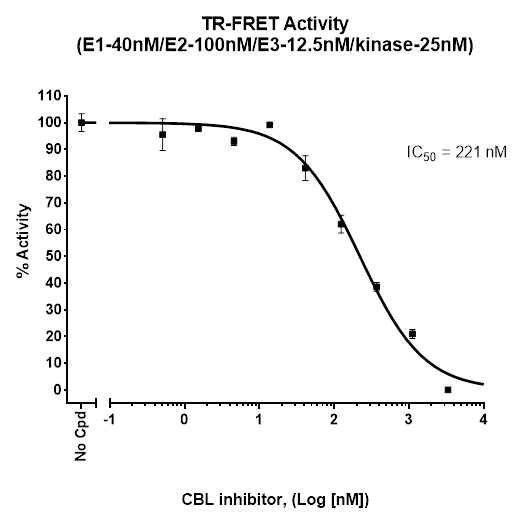C-CBL-Driven Tyro3 Ubiquitination Intrachain TR-FRET Assay Kit
The C-CBL-driven Tyro3 Ubiquitination Intrachain TR-FRET Assay Kit is a sensitive high-throughput screening (HTS) TR-FRET Assay Kit, designed to measure C-CBL E3 ligase activity in a homogeneous 384 reaction format. It utilizes a Europium cryptate-labeled Ub (donor) and a Cy5-labeled Ub (acceptor) to complete the TR-FRET pairing. Since both the TR-FRET donor and acceptor are incorporated into poly-ubiquitin chains, this FRET-based assay requires no time-consuming washing steps, making it especially suitable for high throughput applications as well as real-time analyses of polyubiquitination. Of note, the assay kit does not detect mono-ubiquitination.
Alternatively, under the same experimental conditions the AXL kinase (BPS Bioscience #40180) can be used instead of Tyro3 as C-CBL ubiquitination substrate.

Figure 1. C-CBL-driven Tyro3 ubiquitination intrachain TR-FRET Assay Kit schematic
Need us to run inhibitor screens or profile your compounds against C-CBL-driven Tyro3 Ubiqutination? Check out our Ubiquitination Screening Services.
- Fluorescent microplate reader capable of measuring Time Resolved Fluorescence Resonance Energy Transfer (TR-FRET)
- Adjustable micropipettor and sterile tips
- Rotating or rocker platform
| Catalog # | Name | Amount | Storage | |
| 80301 | UBE1 (UBA1), FLAG-tag* | 40 µg | -80°C | Avoid freeze/ thaw cycles |
| 80314 | UbcH5b, His-Tag* | 60 µg | -80°C | |
| 100370 | C-CBL, GST-Tag* | 8 µg | -80°C | |
| 40293 | TYRO-3, GST-Tag* | 16 µg | -80°C | |
| 78307 | TRF Ubiquitin Mix (200x) | 40 µl | -80°C | |
| ATP (4 mM) | 2 x 1 ml | -80°C | ||
| U2 Assy Buffer | 2 x 10 ml | -80°C | ||
| 79969 | White, nonbinding, low volume microtiter plate | Room Temp | ||
*The initial concentration of protein is lot-specific and will be indicated on the tube containing the protein.
The Ubiquitin Mix is sourced from South Bay Bio LLC.
Covalent conjugation to ubiquitin (Ub) is one of the major post-translational modifications regulating protein stability, function, and localization. Ubiquitination is the concerted action of three enzymes: a Ub-activating enzyme (E1), a Ub-conjugating enzyme (E2), and a Ub ligase (E3). The specificity and efficiency of ubiquitination are largely determined by the E3 enzyme, which directs the last step of the Ub-conjugating cascade by binding to both an E2∼Ub conjugate and a substrate protein. This step ensures the transfer of Ub from E2∼Ub to the substrate, leading to its mono- or poly-ubiquitination.
Casitas B-lineage lymphoma (C-CBL) is a RING-type E3 ligase and a member of the CBL family of proteins that comprises three homologues. It contains an N-terminal tyrosine kinase binding (TKB) domain comprised of a four-helix bundle, a calcium binding EF-hand and a Src homology (SH2) domain, followed by a linker helical region and the RING domain responsible for its catalytic function. Additionally, C-CBL contains proline-rich regions and several tyrosine-phosphorylation sites mediating the association with various targets, as well as a ubiquitin-associated (UBA) domain for ubiquitin binding and dimerization. C-CBL interacts with a large number of target proteins implicated in cell survival, migration and proliferation. The ubiquitin ligase activity of C-CBL is up-regulated by the phosphorylation of Tyrosine (Tyr) 371, which is located in the helix linker between the TKB and RING domains. Phosphorylation of Tyr371 opens C-CBL from its auto-inhibitory conformation, allowing binding to E2 and substrates. C-CBL is phosphorylated by receptor-type tyrosine kinases such as Tyro3, which can also serve as a substrate for C-CBL-mediated ubiquitination.


